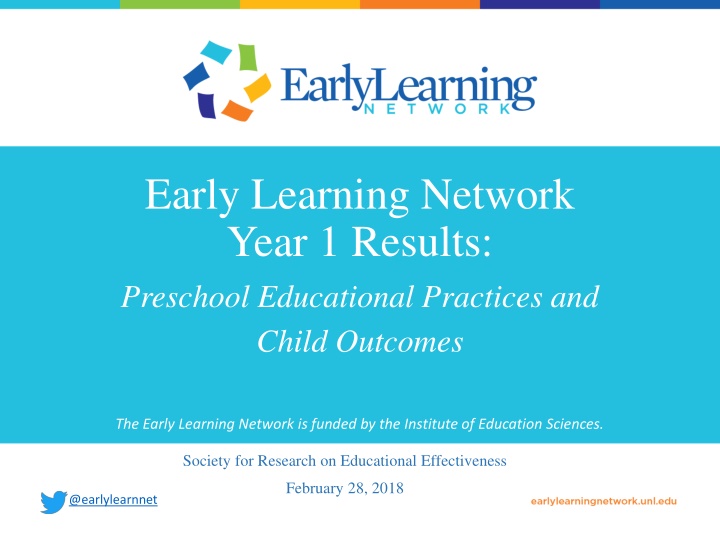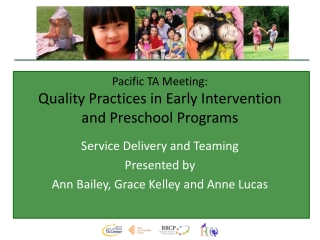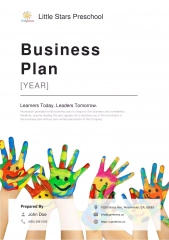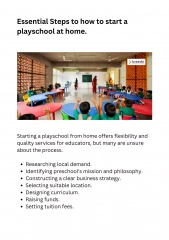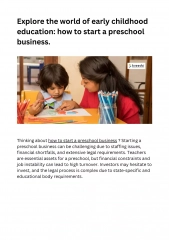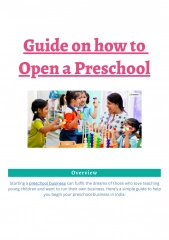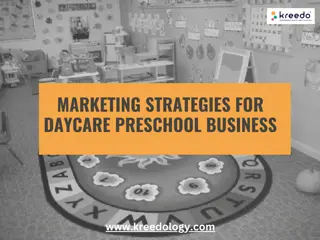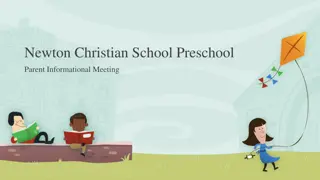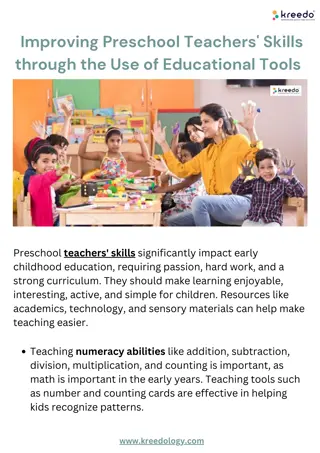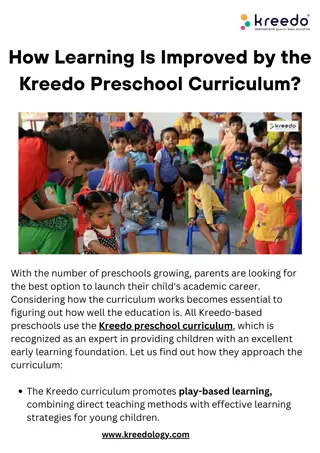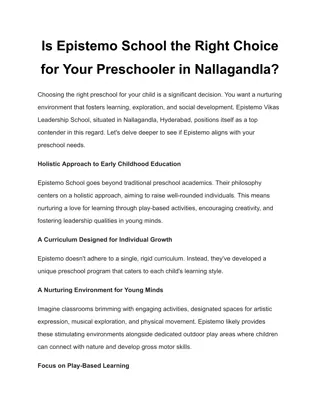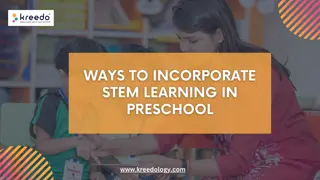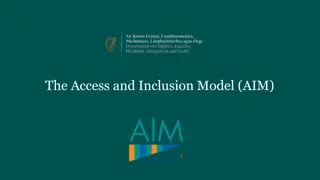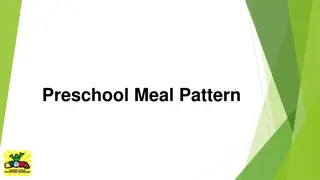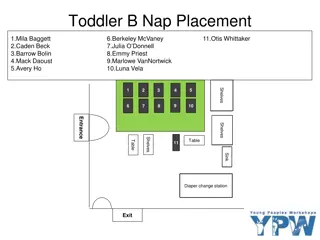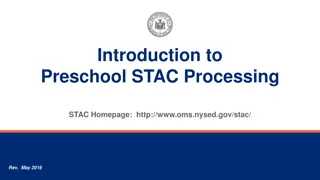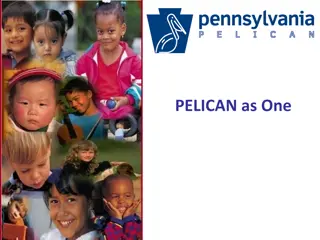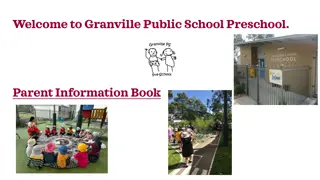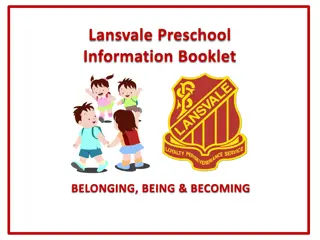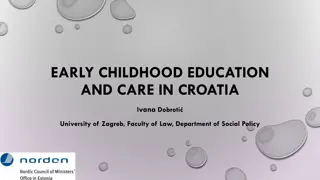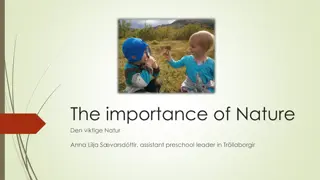Early Learning Network Year 1 Results: Preschool Educational Practices
The Early Learning Network aims to advance policies and practices for preschool to elementary school transition. Research studies focus on identifying supportive factors and malleable aspects for early learning success and academic achievement. Symposium agenda includes papers on classroom characteristics, curricular implementation quality, effects of classroom processes on child outcomes, and classroom quality predicting student outcomes.
Download Presentation

Please find below an Image/Link to download the presentation.
The content on the website is provided AS IS for your information and personal use only. It may not be sold, licensed, or shared on other websites without obtaining consent from the author.If you encounter any issues during the download, it is possible that the publisher has removed the file from their server.
You are allowed to download the files provided on this website for personal or commercial use, subject to the condition that they are used lawfully. All files are the property of their respective owners.
The content on the website is provided AS IS for your information and personal use only. It may not be sold, licensed, or shared on other websites without obtaining consent from the author.
E N D
Presentation Transcript
Early Learning Network Year 1 Results: Preschool Educational Practices and Child Outcomes The Early Learning Network is funded by the Institute of Education Sciences. Society for Research on Educational Effectiveness February 28, 2018 @earlylearnnet
The Early Learning Network aims to advance the understanding of policies and practices that narrow the achievement gap and maintain early learning success as children transition from preschool to elementary school and beyond.
Five Research Teams One Assessment Team Network Lead
Complementary Research Studies Descriptive study: Identify systems-level policies and practices that support early learning Classroom observation study: Identify teaching practices and other classroom-level malleable factors associated with children s school readiness and achievement in preschool and early elementary school Longitudinal study: Identify malleable factors associated with early learning and school achievement over time from preschool through the early elementary school grades
Symposium Agenda Paper 1: Pre-Kindergarten Classroom Characteristics and Pre-Kindergarten Gains of Children Living in Rural Areas University of North Carolina Chapel Hill (Irina Mokrova, Margaret Burchinal, Mary Bratsch-Hines, & Ellen Peisner-Feinberg) Paper 2: How Does Quality of Curricular Implementation Support Diverse Children s Skills in Pre- Kindergarten? Evidence from Boston MDRC/University of Michigan (Meghan McCormick, Michelle Maier, Christina Weiland, JoAnn Hsueh, Jason Sachs, & Catherine Snow) Paper 3: Understanding the Effects of Classroom Processes on Child Outcomes in Pre-Kindergarten University of Virginia (Robert Pianta, Jessica Whittaker, Virginia Vitiello, Erik Ruzek, Arya Ansari, & Tara Hofkens) Paper 4: Classroom Quality and Classroom Network Structure Predicting Student Outcomes Ohio State University (Jessica Logan Kelly Purtell, Tzu-Jung Lin, & Laura Justice) Discussant Carol Connor (University of California-Irvine)
Irina Mokrova Peg Burchinal Mary Bratsch-Hines Ellen Peisner-Feinberg University of North Carolina at Chapel Hill
ECE can reduce achievement gap State and federal pre-kindergarten (Pre-K) programs But questions remain: which dimensions of ECE experiences relate to which Pre-K skills
Process quality Widely examined; modest associations Verbal interactions with adults Associations with language and literacy skills Basis for teacher scaffolding Instruction time Setting Small groups help young children learn Curriculum Wide-scale belief in whole child curricula Evidence for domain-specific curricula
Academic skills Increasing attention in Pre-K classrooms Phonemic skills and letter-word recognition Early numeracy Cognitive skills Higher-order cognitive skills Language Executive functioning
Domain specificity Instruction time in that domain Use of domain-specific curriculum Academic skills related to Classroom process quality Small group settings Cognitive skills related to Classroom process quality Complex conversations with teacher Small group settings
Cohort study of rural NC 6 NC rural counties 63 randomly selected NC Pre-K classrooms Pre-K children 351randomly selected children 34% Spanish-English dual language learners Classroom quality, observed 2 days CLASS Boston Pre-K fidelity checklist Language Interactions Snapshot (LISn) Teacher report of curriculum
Factor analysis of classroom observation measures 1. Process Quality CLASS Domains - ES, CO, IS Boston pre-K fidelity checklist 2. Complex conversations with adults - LISn any adult elicited, elaborated, and had sustained conversation 3. Instruction LISn Literacy activities (print, writing, sound) Math activities
4. Curriculum: teacher report Creative Curriculum used in 78% classrooms 5. Setting: LISn large group small group
Process Quality Process Quality Complex conver sation .27* Complex conver- - sation Literacy Activities Literacy Activities Sounds Activities Sounds Activities Math Activities Math Activities Small Group Small Group Whole Group Whole Group Creative Curric Creative Curric. . Process quality .16 -.04 .13 -.10 .25* .20 Complex conver- sation Literacy Activities Sounds Activities Math Activities Small group .34** .24+ .47*** .35** .07 -.18 .63*** .05 .01 .21+ -.24+ .12 .00 .05 -.37** .50*** .06 -.34** -.27* -.24+ Whole group -.13
Children assessed fall and spring gain scores Academic skills Literacy WJ Letter-word ID DIBELS First sound fluency DIBELS Phonemic fluency Numeracy WJ Applied problems Cognitive skills Language Expressive One Word (English and Spanish) WJ Picture vocabulary Executive function Inhibitory control (Flanker) Cognitive Flexibility (Card sort)
Children nested in classrooms First model: All quality dimensions and controls Subsequent models: Taking out quality dimensions one at a time Reduced model: One or more dimensions became significant
Letter- Word ID Applied Problems 1st Sound Fluency Phoneme Fluency Picture Vocab EOW English EOW Span. Inhibitory Control Cognitive Flexibility Process Quality .23*** Complex Conversation .18* Literacy Activities .26** Math Activities Sound Activities .16** .14* Small Group Setting .14* Whole Group -.13* -.17* Creative curriculum -.21*** -.14* n 351 349 350 349 334 240 103 273 227
All but one outcome related to at least one quality dimension No clear pattern Most outcomes related to a single dimension No single quality dimension dominated Predictors of academic skills are not clearly different from cognitive skills
Focus on other dimensions in addition to process quality may be warranted Time in content-related instruction Type of setting Language as a tool for scaffolding Whole child curriculum negatively related to some academic or cognitive gains Scaffolding needs to be a process behind any curriculum
To all participating families, teachers, and school administrators To all research assistants and project staff To the Institute of Education Sciences
How Does Quality of Curricular Implementation Support Diverse Children s Skills in Prekindergarten?: Evidence from Boston Meghan McCormick Michelle Maier Christina Weiland JoAnn Hsueh Jason Sachs Catherine Snow February 28th, 2018 2018 Society for Research on Educational Effectiveness Washington, DC
Current issues in the field of early education Some evaluations demonstrate large to moderate impacts of PreK while others show null effects. Mixed evaluation results Combination of intended pedagogy, content, instructional activities and practices thought to shape child Role of implement- ation outcomes Tool to assess implementation fidelity can break apart components to understand whether, how, and for whom fidelity links to child outcomes. Assessing fidelity in the field
The BPS Model as a Case Study for Examining Fidelity of Implementation Curriculum in place Example components adapted from OWL Example Building Blocks components Example district- developed components Focus on K1 (district-adapted version of Opening the World of Learning & Building Blocks). Thematic curriculum that cuts across ELA, math, science, social study, and arts. Centers & Introduction to Centers Building Blocks centers Thinking & feedback Read Aloud Building Blocks whole group activities Storytelling Small Groups to support language/literacy Building Blocks small group activities Storyacting
Research questions 1. What does fidelity look like across prekindergarten public school classrooms in BPS? Does fidelity vary systematically by classroom composition? 2. What measures of fidelity are most closely associated with CLASS? 3. Is fidelity to the BPS PreK model associated with children s language and math scores in the Spring of PreK? For which groups of students does fidelity appear most predictive of Spring outcomes (e.g., dual language learners, racial/ethnic minority students)?
Schools participating in study (N = 20 public schools with prekindergarten program) School-level characteristic % for study schools % for school district School structure: PreK 5th grade 30% 50% School structure: PreK 1st grade 5% 8% School structure: PreK 8th grade 55% 32% % Students economically disadvantaged 48.38% 51.05% % Students Black 25.59% 31.60% % Students White 15.70% 16.17% % Students Hispanic 46.43% 42.37% % Students Asian 8.50% 5.99% % Students whose first language is not English 49.15% 41.90% % Met or exceeded expectations on 2015 2016 ELA exam 39.74% 35.95% % Met or exceeded expectations on 2015 2016 math exam 44.47% 41.48%
Classroom & teacher participants (N = 41 public school classrooms across 20 schools) Teacher characteristic %age/Mean Teacher age 43.95 (SD = 9.37) Years teaching 14.79 (SD = 9.25) Years teaching prekindergarten 8.6 (SD = 7.37) Years teaching at current school 7.79 (SD = 8.01) Teacher has master s degree 90% Teacher female 100% Teacher Black 22% Teacher White 49% Teacher Hispanic 13% Teacher Asian or other race 16% Classrooms per school 1.35 (SD = .42)
Student sample (N = 299 BPS prekindergarten students) 100% 90% 80% 70% 60% Study sample 50% 40% All BPS prekindergarten students 30% 20% 10% 0% Eligible FRPL White Black Hispanic Asian DLL
Research & BPS teams Co-construct Tool to Measure Fidelity of Implementation Research team conducts in- depth curriculum review and meets with BPS staff Research team develops fidelity tool and iteratively edits it following meetings with BPS staff Training and reliability procedures take into account BPS staff feedback Further edits and adaptation following field- based piloting with BPS staff BPS instructional coaches collect data in classrooms
Fidelity Data in Public School Classrooms 41 total public prekindergarten classrooms participated (97% of teachers in participating schools) N = 41 classrooms in 20 schools Each classroom observed on two separate days for 2 3 Classrooms observed 2x hours/obs. Observation data averaged across days. 20% of observational visits were coded by two BPS coaches; Reliability analysis suggests high agreement. Reliability
Procedure (thus far) for analyzing fidelity data 1. Examine dosage, adherence, and quality of implementation 2. Examine fidelity scores within curriculum components 3. Consider variation within and across components 4. In order to make fidelity relevant to district - create measures that cut across components and operationalize core practices that are central to curriculum
Cross-component fidelity measures Vocabulary ( = .91) Extending/Building ( = .91) Summary/ Reflection/Making Connections ( = .79) Scaffolding/ Differentiation ( = .82)
What does fidelity look like overall in BPS public school prekindergarten classrooms? 5 4.5 Fidelity score (1 - 5) 4 3.5 3 2.5 2 1.5 1
How does this compare to CLASS scores? 7 6 CLASS Domain Scores 5 4 3 2 1 Emotional support Classroom organization Instructional support
How does implementation vary depending on classroom composition? There are some differences in implementation between classrooms. On average: Classrooms with higher percentages of white students have higher quality of implementation Classrooms with higher percentages of black and Hispanic students have lower quality of implementation Classrooms with higher percentages of DLLs have similar quality of implementation as classrooms with fewer DLLs, but more variation across classrooms.
Example of variation in fidelity by classroom composition: Eligibility for free/reduced price lunch 100% 90% 80% 70% 60% 50% Study sample 40% 30% All BPS prekindergarten students 20% 10% 0%
How do fidelity measures relate with CLASS? Instructional support Emotional support Classroom org. Instructional support 1.0 Emotional support .67 1.0 Classroom org. .69 .85 1.0 Extending/Building .18 .16 .10 Summary/Reflection .22 .10 .14 Vocabulary .01 .01 -.07 Scaffolding/Differentiation .35 .21 .22
Is fidelity associated with childrens language/math skills in the Spring of PreK?: Some preliminary findings Two-level models with classroom-level random intercepts. Outcomes: PPVT assessed in the Spring of 2017 Woodock Johnson Applied Problems (5% of sample tested in Spanish) from Spring 2017 Covariates: Fall 2016 level of the outcome, child race (white reference group), FRPL eligibility, DLL status, female, child age, CLASS domains Interactions used to test how associations vary by race/ethnicity, FRPL, and DLL status
Student math skills across the prekindergarten year 115 113 111 WJAP Standardized Score Full sample 109 White students 107 Black students Hispanic students 105 Asian students 103 FRPL eligible 101 Not FRPL eligible 99 DLLs 97 95 Fall 2016 Spring 2017
Links between fidelity of implementation and improvements in language and math across prekindergarten year Full sample of students - no significant associations between cross-component fidelity measures and gains in language or math across prekindergarten year No significant associations detected in this preliminary work using cross-component fidelity constructs to predict PPVT outcomes Statistically significant interactions between fidelity of implementation, Hispanic and DLL status, and math outcome
Example of Predicted Math Skills for Hispanic Students at End of Prekindergarten Year 104 WJ Applied Problems Standard Score 103 102 101 100 High fidelity 99 Low fidelity 98 97 96 95 Extending/building Summary/reflection
Example of Predicted Math Skills for White Students at End of Prekindergarten Year 120 WJ Applied Problems Standard Score 115 110 High fidelity Low fidelity 105 100 95 Extending/building Summary/reflection
Example of Predicted Math Skills for Dual Language Learner Students at End of Prekindergarten Year 110 WJ Applied Problems Standard Score 109 108 107 106 105 High fidelity 104 Low fidelity 103 102
Limitations & Next Steps Work is very preliminary and in early stages Future models will include more rigorous work to determine covariates and alternative model fits. More measurement work needed to operationalize fidelity constructs and consider any within- component measures of adherence, dosage, quality Data are correlational across one school year Sample is fairly small in Year 1 study (particularly for subgroups); future years will include larger samples for subgroup examination
Some preliminary conclusions Reliable fidelity data can be collected by district staff. Systematic variation in fidelity across classrooms. Fidelity may predict math outcomes (on a small magnitude) but story is likely in the subgroups for a diverse sample with varying skill levels at baseline and follow-up.
Acknowledgments MDRC Marissa Strassberger Rama Hagos Sharon Huang Jared Smith Desiree Alderson Ilana Blum Kelly Terlizzi Mirjana Pralica University of Michigan Deborah Ball Lillie Moffett Paola Rosado Amanda Ketner Harvard Nonie Lesaux Sibyl Holland Maia Gokhale Data collection team BPS Brian Gold Abby Morales Marina Boni Melissa Luc David Ramsey BPS Dept. of Early Childhood Staff
Funding Acknowledgment The research reported here was supported by the Institute of Education Sciences, Department of Education, through Grant R305N160018 17 to MDRC. The opinions expressed are those of the authors and do not represent views of the Institute or U.S. Department of Education.
Questions? Meghan McCormick MDRC meghan.mccormick@mdrc.org Michelle Maier MDRC meghan.mccormick@mdrc.org Christina Weiland University of Michigan weilandc@umich.edu JoAnn Hsueh MDRC joann.hsueh@mdrc.org Jason Sachs Boston Public Schools jsachs@bostonpublicschools.org Catherine Snow Harvard Graduate School of Education Catherine_snow@gse.harvard.edu
Understanding the effects of classroom processes on child outcomes in pre-kindergarten Robert C. Pianta, PhD February 28, 2018 July 17, 2017 48
Research Team Robert Pianta Jessica Whittaker Ginny Vitiello Erik Ruzek Marcia Kraft-Sayer Brittany Kerr Laura Helferstay Marianna Lyulchenko Arya Ansari Tara Hofkens Partners: School district, IES, ELN 49
FP3 Pre-K Year Early Results Sample information Descriptions of classroom practices and opportunity Early results from outcome analyses 50
